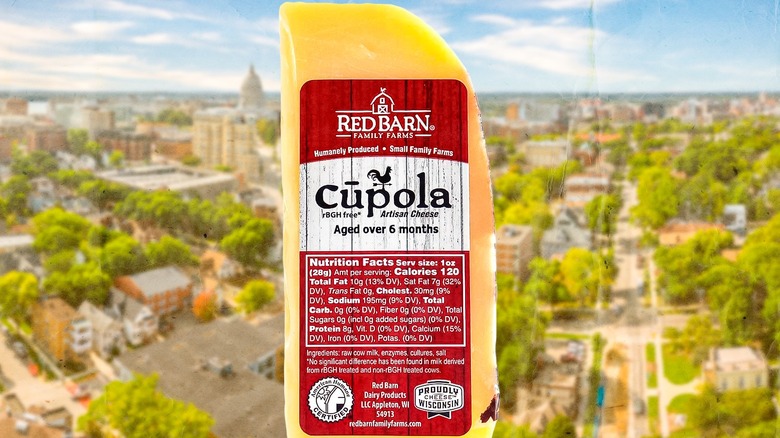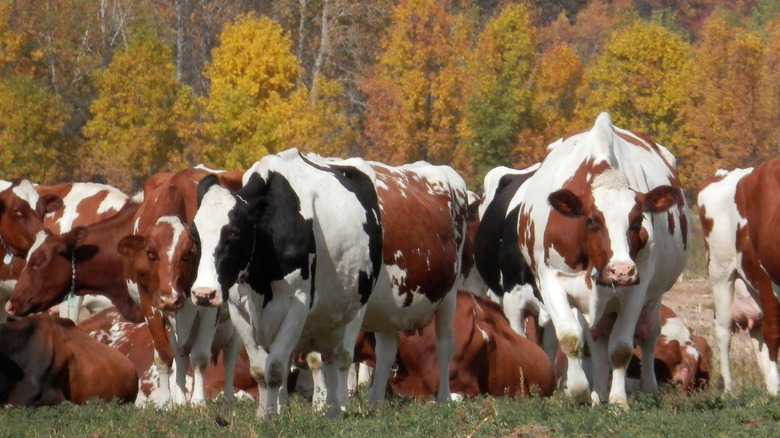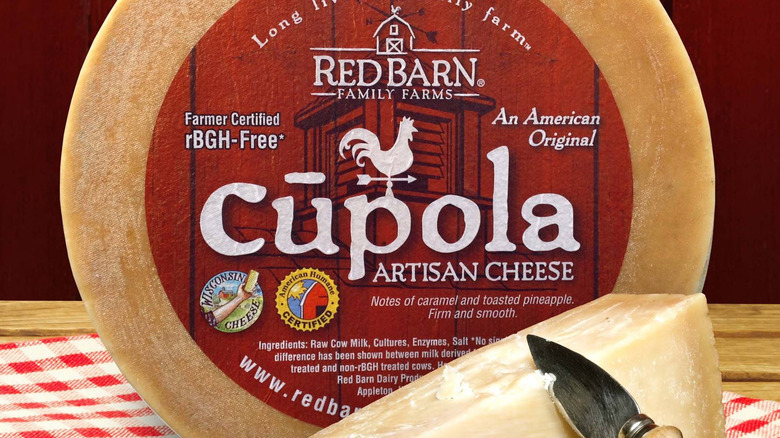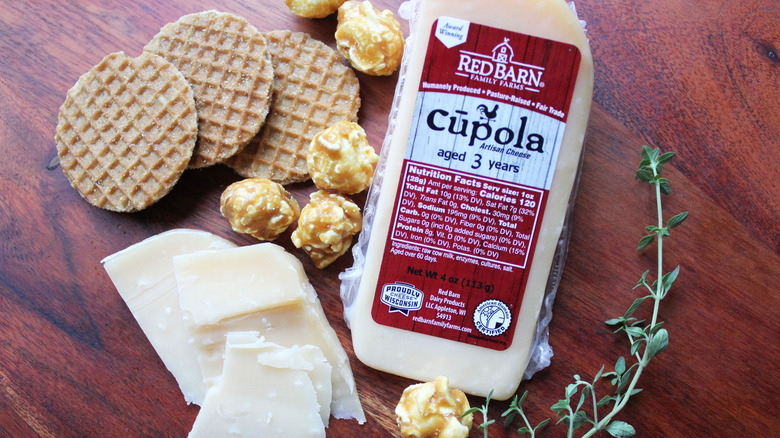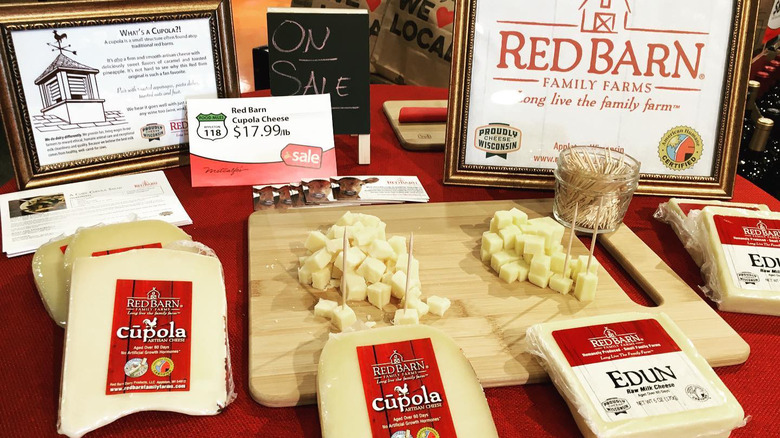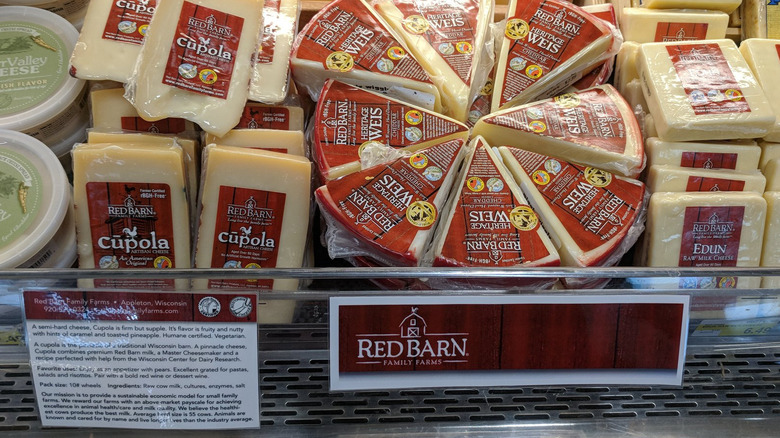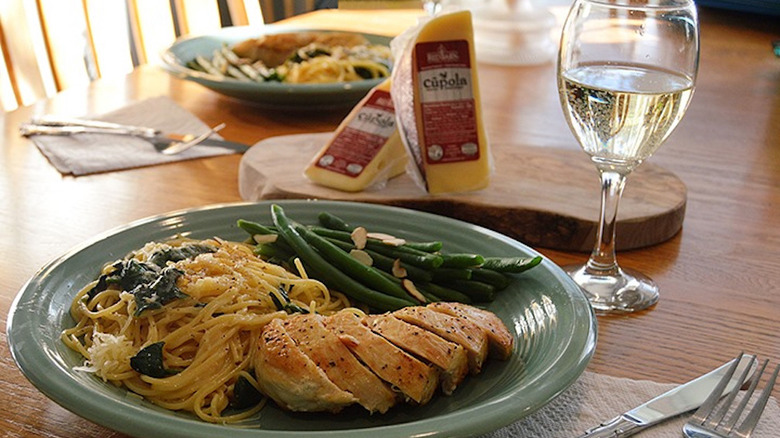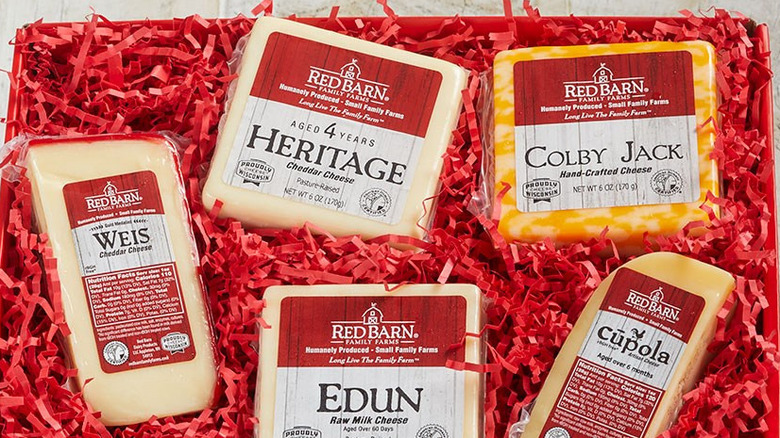Cupola Is The Wisconsin Cheese You May Not Know About
In the world of Wisconsin cheeses, Cupola is a new kid on the block. Named for the small domes typically found on top of Wisconsin's barns, Cupola is an American raw milk cheese developed jointly with the Center for Dairy Research at the University of Wisconsin-Madison. The recipe for this handmade cheese took three years to develop, and that time has paid off. Since it was first introduced in 2014, Cupola cheese has won numerous awards, including first runner-up and best in class for hard cheeses in the 2023 United States Championship Cheese contest.
Produced by Red Barn Family Farms, a company dedicated to ethical dairy farming, Cupola is an artisanal, alpine-style cheese. Alpine cheeses made in Wisconsin combine the traditional methods used in the Alps with modern cheesemaking techniques.
High-quality milk is part of what sets Cupola apart from other cheeses. Red Barn Family Farms sources its milk from seven specially selected small dairy farms that match their commitment to humane farming practices. Cows on these farms enjoy grazing time outside and are fed a healthy diet without performance-boosting antibiotics. The result is cheese made from milk provided by cows that are well-fed, healthy, and humanely treated.
How is Cupola made?
Milk, and rennet, and cultures, oh my! These are just a few of the basic ingredients used to make cheese from scratch. While the process might sound like a science experiment to most people, the expert cheesemakers in Wisconsin have mastered the art of turning them into incredibly delicious cheeses, like Cupola.
"[Cupola] does not fit neatly into a specific cheese category," explained Paula Homan, co-founder of Red Barn. "Cupola is handmade in small batches with the key ingredient being our premium, humanely produced milk from Red Barn Family Farm's group of small-scale, family-owned and operated dairy farms, where cows are still known and cared for by name."
Red Barn relied on their high-quality milk to lead the way in developing Cupola's flavor profile. The company's cheesemakers took their time researching and creating the perfect culture cocktail, one that highlighted the taste of their natural milk instead of centering the flavor on other ingredients like herbs or peppers.
Red Barn's mission to advocate for ethical and humane dairy farming played a significant role in the development of Cupola. Red Barn's dairy farmers must follow rules that make sure their milk is of the highest quality, and take the well-being of the cows into consideration, as well.
What does Cupola taste like?
There are many factors that affect the taste of cheese. Everything from the diet of the cows that produce the milk to how long a cheese is aged to the cultures used to create the cheese all play a role in developing its flavor. Even serving cheese when it's too cold can be detrimental to the flavor, since cheese tastes better at room temperature.
There are two varieties of Cupola available: Cupola Artisan Cheese and Vintage Cupola. Cupola Artisan Cheese is aged for a minimum of six months, and Vintage Cupola is aged for three years. The result is a semi-hard, raw milk cheese that combines "the nutty, sweet notes reminiscent of a Parmesan, along with the smooth texture of a Gouda," according to Homan. Wisconsin Cheese describes Cupola as having a "fruity and nutty flavor that hints at caramel and toasted pineapple."
When the Vintage Cupola is aged for three years, the flavor transforms into a fruit-forward cheese full of the crunchy crystallization that develops as the protein chains in the cheese deteriorate when it is aged.
What to pair with Cupola
Deciding what to pair with cheese is an art form based on choosing flavors that complement each other. A rich, creamy cheese, like Brie, pairs well with a crisp, light sparkling wine like Champagne and a crunchy slice of toasted bread. Sharp cheddar cheese and a bold Cabernet Sauvignon are a delicious match. Add in a few slices of a tart Granny Smith apple, and you'll have a perfect full-flavored bite. The key is in the contrast of flavors and textures. Sweet balances salty. Light complements rich. Soft counters crunchy.
Cupola is described as a cross between Gouda and Parmesan. Its flavor palate is simultaneously fruity and nutty with a slight sweetness. That sweetness makes it the perfect pairing for medium- to full-bodied wines like Malbec and Riesling. Cupola also pairs well with Belgian beers and sipping alcohols like brandy and Port. The Vintage Cupola can be paired with everything from ale to sparkling wine to bourbon.
For food pairings, Cupola works well on a cheese board along with salami, crackers, and sweet pepper jellies. The vintage version makes an excellent dessert cheese. The cheesemakers at Red Barn Family Farms recommend serving it with caramels, popcorn, or stroopwafels, the caramel-filled Dutch waffle cookies first produced in the same city where Gouda cheese originated.
Where to buy Cupola
Cupola is a regional cheese. The dairy farms producing the milk that's used to make the cheese are Wisconsin-based, as are the three creameries that transform the milk into Cupola. Both Cupola Artisan and Cupola Vintage are sold in 8 pound wheels and in smaller wedges.
If you're in Wisconsin, you can find Cupola at a wide variety of independently owned retailers and grocery stores. It's also available in several stores around the Midwest, as well as Central Market locations in Texas, and all Tops Friendly Markets in New York, Pennsylvania, and Vermont.
You can order Red Barn Family Farms cheeses through their online shop in collections ranging in price from $35 to $55, subject to availability. The Award Winning Duo package contains 12 ounces of Cupola Artisan Cheese — which was a 2019 and 2023 American Cheese Society Gold Medalist — and 12 ounces of Vintage Aged Cupola, which was first runner-up in the 2023 U.S. Championship Cheese Contest, a 2022 American Cheese Society Gold Medalist, and a 2023 American Cheese Society Silver Medalist.
The Meet Mable wholesale website sells Cupola and Vintage Aged Cupola in 8 pound wheels. It also stocks packages of Cupola in a case of 20 4-ounce wedges.
How to store Cupola
Knowing how to store cheese properly can extend its shelf life, giving you more time to enjoy it safely. It can also help prevent one of the great kitchen disappointments — unwrapping a piece of cheese you've been dreaming about just to find it moldy or past its prime. There's more to storing cheese than slapping some plastic wrap around an open wedge and tucking it into the fridge.
True cheese lovers remove it from the packaging it comes in and wrap it in porous-plastic-lined cheese paper (or wax paper if cheese paper is unavailable) before placing it in an airtight container or plastic bag.
Cupola should be stored in the refrigerator at temperatures between 39-46 degrees Fahrenheit. "Once the package has been opened, we recommend wrapping the cheese tightly in waxed paper or parchment paper and storing it in the refrigerator," says Homan.
Avoid wrapping your cheese in plastic wrap, which doesn't allow the cheese to breathe. Cheese is packaged in plastic to prevent it from absorbing the smells and flavors of its environment. It works for the time that the cheese is produced, packaged, and sold, but it's not the best solution for long-term storage.
How to serve Cupola
Cupola makes a delicious addition to your cheese boards, but this specialty cheese has much more to offer. Its semi-hard texture is a cross between Parmesan and Gouda, so you can use it in many of the same ways as you would those two cheeses. Use it to finish portions of pasta by sprinkling them generously with grated Cupola.
Its nutty, fruity flavor creates a balance when added to dishes with big, bold flavors like Bolognese sauce. Cupola melts beautifully, so grate it and stir it into your risotto, or dress up your orzo and grilled vegetables with a generous handful.
Red Barn Family Farms' Cozy Cupola Salad recipe highlights the cheese's versatility. Salad greens are tossed with sliced apples and almonds, figs, and shaved Cupola. A maple vinaigrette rounds out the perfectly balanced flavors in this salad. Cupola is also the star ingredient in Lauren Lane's Spring Pasta Salad recipe. In both recipes, Cupola is complemented by flavors that create balanced dishes.
You can add grated or shaved Cupola to the cheese mix of your next grilled cheese, or in macaroni and cheese. Brighten up a grilled chicken Caesar salad with shaved Cupola, or replace the Parmesan cheese powder with Cupola the next time you're enjoying a pizza.
Other varieties of Red Barn cheese
Red Barn Family Farms makes several types of cheese with both raw and pasteurized milk. Their Heritage White Cheddar, Monterey Jack, Colby Jack, and wax-dipped Weis cheddar are made with pasteurized milk. Cupola isn't the only award-winning cheese Red Barn produces. Their Weis cheddar varieties have also won gold medals from both the U.S. and World Championship Cheese Contests.
Like Cupola, Red Barn's Edun cheese is an original recipe cheese made with raw milk, which means it's unpasteurized. Milk is often pasteurized before it's used to make cheese. In fact, it's illegal to sell raw milk in some states. According to the Food and Drug Administration, cheeses made with raw milk are legal to sell so long as they are aged for a minimum of 60 days at 35 degrees Fahrenheit or more. This gives the cheese time to build up a natural resistance to harmful bacteria growth.
Red Barn Family Farm's cheeses offer a delicious taste of the variety and quality of Wisconsin cheese.
